Marine Debris in the Beilun Estuary Mangrove Forest: Monitoring, Assessment and Implications
Abstract
:1. Introduction
2. Methodology
2.1. Method Establishment
- (1)
- Sampling location, time and area
- (2)
- Materials, size and sources
- (3)
- The density estimation and assessment
2.2. Application and Practice in Beilun Estuary Mangrove Region
3. Results and Discussion
3.1. Space Distribution of Marine Debris
3.2. Density and Total Debris Weight in Beilun Estuary Mangrove Forest Region
3.3. Size of the Debris in Beilun Estuary Mangrove Forest Region
3.4. Debris Distribution Influenced by Flood-Ebb Fluctuations
3.5. Plastic Debris Pollution and Assessment
4. Conclusions
Author Contributions
Funding
Institutional Review Board Statement
Informed Consent Statement
Data Availability Statement
Acknowledgments
Conflicts of Interest
References
- Zhang, Q.; Sui, S. The Mangrove wetland resources and their conservation in China. J. Nat. Resour. 2001, 16, 28–36, (In Chinese with Abstract). [Google Scholar]
- Duan, S.; Xu, J. Functions of mangrove wetlands in the conservation of the coastal ecosystems. Ecol. Sci. 2004, 23, 351–355, (In Chinese with Abstract). [Google Scholar]
- Li, X.L. A Study on The Mixed-Species Flock in Mangrove Reserve of Beilun Estuary. Master’s Thesis, Guangxi University, Nanning, China, 2007; pp. 1–49, (In Chinese with English Abstract). [Google Scholar]
- Yessoufou, K.; Stoffberg, G.H. Biogeography, threats and phylogenetic structure of mangrove forest globally and in South Africa: A review. S. Afr. J. Bot. 2016, 107, 114–120. [Google Scholar] [CrossRef]
- Rovai, A.S.; Twilley, R.R.; Castañeda-Moya, E.; Riul, P.; Cifuentes-Jara, M.; Manrow-Villalobos, M.; Horta, P.A.; Simonassi, J.C.; Fonseca, A.L.; Pagliosa, P.R. Controls on carbon storage in mangrove soils. Nat. Clim. Chang. 2018, 8, 534–538. [Google Scholar] [CrossRef]
- Huang, Q.S. Evaluation on the Value of Mangrove Ecosystem Services at Beilun Estuary of Guangxi. Nanning. Master’s Thesis, Guangxi Normal University, Nanning, China, 2018; pp. 1–60, (In Chinese with English Abstract). [Google Scholar]
- Not, C.; Lui, C.Y.I.; Cannicci, S. Feeding behavior is the main driver for microparticle intake in mangrove crabs. Limnol. Oceanogr. Lett. 2020, 5, 84–91. [Google Scholar] [CrossRef] [Green Version]
- GESAMP. Guidelines for the Monitoring and Assessment of Plastic Litter and Microplastics in the Ocean; Kershaw, P.J., Turra, A., Galgani, F., Eds.; United Nations Environment Programme (UNEP): Nairobi, Kenya, 2019; p. 130. [Google Scholar]
- Martin, C.; Almahasheer, H.; Duarte, C.M. Mangrove forests as traps for marine litter. Environ. Pollut. 2019, 247, 499–508. [Google Scholar] [CrossRef]
- Roman, L.; Bell, E.; Wilcox, C.; Hardesty, B.D.; Hindell, M. Ecological drivers of marine debris ingestion in Procellariiform Seabirds. Sci. Rep. 2019, 9, 916. [Google Scholar] [CrossRef]
- Watters, D.L.; Yoklavich, M.M.; Love, M.S.; Schroeder, D.M. Assessing marine debris in deep seafloor habitats off California. Mar. Pollut. Bull. 2010, 60, 131–138. [Google Scholar] [CrossRef]
- Zhou, P.; Huang, C.; Fang, H.; Cai, X.; Li, D.; Li h Yu, H. The abundance, composition and sources of marine debris in coastal seawaters or beaches around the northern South China Sea (China). Mar. Pollut. Bull. 2011, 62, 1998–2007. [Google Scholar] [CrossRef] [PubMed]
- NOWRAP MERRAC. Northwest Pacific Action Plan, Marine Environmental Emergency Preparedness and Response Regional Activity Centre. Guidelines for Monitoring Marine Litter on the Seabed in the Northwest Pacific Region. 2007. Available online: http://merrac.nowpap.org/merrac/publication/select_marineLitter_list/page/20?search_key=all&search_word=&conts_sn=EE0104&conts_sn_full=EE010401&gnb=publication&snb=Marine+Litter+Report&bbs_no=&page_url= (accessed on 14 June 2021).
- NOWRAP CEARAC. Coastal Environmental Assessment of Regional Activity Centre, Northwest Pacific Action Plan. Guidelines for Monitoring Marine Litter on the Beaches and Shorelines of the Northwest Pacific Region. 2007. Available online: https://www.doc88.com/p-189619384974.html?s=rel&id=1 (accessed on 14 June 2021).
- SOA of China. State Oceanic Administration China. Guideline for Marine Debris Monitoring and Assessment (Provisional) (First Edition). 2011. Available online: http://f.mnr.gov.cn/201806/t20180628_1960651.html (accessed on 18 December 2015). (In Chinese)
- Brander, S.M.; Fontana, R.E.; Mata, T.M.; Gravem, S.A.; Hettinger, A.; Bean, J.R.; Szoboszlzai, A.; Keiper, C.A.; Marrero, M.E. The Ecotoxicology of Plastic Marine Debris. Am. Biol. Teach. 2011, 73, 474–478. [Google Scholar] [CrossRef]
- Guo, F.; Zhou, P.; Li, Z.; Qin, Y. The abundance, composition and sources of marine debris in the coastal East China Sea in 2011. Trans. Oceanol. Limnol. 2014, 3, 193–200. [Google Scholar]
- Mace, T. At-sea detection of marine debris: Overview of technologies, processes, issues, and options. Mar. Pollut. Bull. 2012, 65, 23–27. [Google Scholar] [CrossRef] [PubMed]
- Moy, K.; Neilson, B.; Chung, A.; Meadows, A.; Castrence, M.; Ambagis, S.; Davidson, K. Mapping coastal marine debris using aerial imagery and spatial analysis. Mar. Pollut. Bull. 2018, 132, 52–59. [Google Scholar] [CrossRef] [PubMed]
- Lebreton, L.; Slat, B.; Ferrari, F.; Sainte-Rose, B.; Aitken, J.; Marthouse, R.; Hajbane, S.; Cunsolo, S.; Schwarz, A.; Levivier, A.; et al. Evidence that the Great Pacific Garbage Patch is rapidly expanding. Sci. Rep. 2018, 8, 4666. [Google Scholar] [CrossRef] [PubMed] [Green Version]
- Fallati, L.; Polidori, A.; Salvatore, C.; Saponari, L.; Savinia, A.; Gall, P. Anthropogenic Marine Debris assessment with Unmanned Aerial Vehicle imagery and deep learning: A case study along the beaches of the Republic of Maldives. Science 2019, 693, 133581. [Google Scholar] [CrossRef] [PubMed]
- Andriolo, U.; Gonçalves, G.; Sobral, P.; Fontán-Bouzas, Á.; Bessaf, F. Beach-dune morphodynamics and marine macro-litter abundance: An integrated approach with unmanned aerial system. Sci. Total. Environ. 2020, 749, 141474. [Google Scholar] [CrossRef]
- Nakashima, E.; Isobe, A.; Magome, S.; Kako, S.I.; Deki, N. Using aerial photography and in situ measurements to estimate the quantity of macro-litter on beaches. Mar. Pollut. Bull. 2011, 62, 762–769. [Google Scholar] [CrossRef] [PubMed]
- Ivar do Sul, J.A.; Costa, M.F.; Silva-Cavalcanti, J.S.; Araújo, M.C.B. Plastic debris retention and exportation by a mangrove forest patch. Mar. Pollut. Bull. 2014, 78, 252–257. [Google Scholar] [CrossRef]
- Nor, N.H.M.; Obbard, J.P. Microplastics in Singapore’s coastal mangrove ecosystems. Mar. Pollut. Bull. 2014, 79, 278–283. [Google Scholar] [CrossRef]
- Rahim, S.; Widayati, W.; Analuddin, K.; Saleh, F.A.; Sahar, S. Spatial Distribution of Marine Debris Pollution in Mangrove-Estuaries Ecosystem of Kendari Bay. IOP Conf. Ser. Earth Environ. Sci. 2020, 412, 12006. [Google Scholar] [CrossRef] [Green Version]
- Lima, A.R.A.; Barletta, M.; Costa, M.F.; Ramos, J.A.A.; Dantas, D.V.; Melo, P.A.M.C.; Justio, A.K.S.; Ferreira, G.V.B. Changes in the composition of ichthyoplankton assemblage and plastic debris in mangrove creeks relative to moon phases. J. Fish. Biol. 2016, 89, 619–640. [Google Scholar] [CrossRef] [PubMed]
- Zhou, Q.; Tu, C.; Fu, C.; Li, Y.; Zhang, H.; Xiong, K.; Zhao, X.; Li, L.; Waniek, J.J.; Luo, Y. Characteristics and distribution of microplastics in the coastal mangrove sediments of China. Sci. Total. Environ. 2020, 703, 134807. [Google Scholar] [CrossRef] [PubMed]
- Fan, H.; Wang, X.; He, B.; Pan, L. Artificial Habitat Establishment and Mangrove Rehabilitation; Forestry Publishing House: Beijing, China, 2014. (In Chinese) [Google Scholar]
- Hu, G.; Li, J.; Qin, Y.; Hu, B.; Liu, X.; Zhang, Z. Population structure and dynamics of mangrove species in Beilun Estuary, Guangxi, southern China. Acta Ecol. Sin. 2018, 38, 3022–3034. [Google Scholar] [CrossRef]
- Xiong, X.; Wang, X.; Zhou, H.; Wu, P. The distribution of mangrove bacteria in intertidal surface sediments of the Beilun estuary. Mar. Environ. Sci. 2008, 3, 101–106. [Google Scholar] [CrossRef]
- Dan, X.; Liao, B.; Wu, Z.; Wu, H.; Bao, D.; Dan, W.; Liu, S. Resources, protection status and major threats of Chinese mangrove wetland (in Chinese). Ecol. Environ. Sci. 2016, 25, 1237–1243. [Google Scholar] [CrossRef]
- Deidun, A.; Gauci, A.; Lagorio, S.; Galgani, F. Optimising beached litter monitoring protocols through aerial imagery. Mar. Pollut. Bull. 2018, 13, 212–217. [Google Scholar] [CrossRef]
- Jayapala, H.P.S.; Jayasiri, H.B.; Ranatunga, R.R.M.P.K.; Amarasiri, C. Marine debris and its potential impacts on mangrove ecosystem in Negombo Lagoon. National Aquatic Resources Research and Development Agency (NARA). In Proceedings of the International Scientific Sessions, Crow Island, Sri Lanka, 25 July 2018; p. 33. [Google Scholar]
- UNEP (United Nations Environment Programme). Marine Plastic Debris and Microplastics-Global Lessons and Research to Inspire Action and Guide Policy Change; United Nations Environment Programme (UNEP): Nairobi, Kenya, 2016; p. 252. [Google Scholar]
- Rees, G.; Pond, K. Marine litter monitoring programmes-A review of methods with special reference to national surveys. Mar. Pollut. Bull. 1995, 30, 1113–1118. [Google Scholar] [CrossRef]
- Lebreton, L.C.M.; van der Zwet, J.; Damsteeg, J.W.; Slat, B.; Andrady, A.; Reisser, J. River plastic emissions to the world’s oceans. Nat. Commun. 2017, 8, 15611. [Google Scholar] [CrossRef]
- Stefatos, A.; Charalampakis, M.; Papatheodorou, G.; Ferentinos, G. Marine debris on the seafloor of the Mediterranean Sea: Examples from two enclosed gulfs in western Greece. Mar. Pollut. Bull. 1999, 38, 389–393. [Google Scholar] [CrossRef]
- Spengler, A.; Costa, M.F. Methods applied in studies of benthic marine debris. Mar. Pollut. Bull. 2008, 56, 226–230. [Google Scholar] [CrossRef]
- Liebezeit, G. Marine litter on the Kachelotplate, Lower Saxonian Wadden Sea. Senckenbergiana Marit. 2008, 38, 147–151. [Google Scholar] [CrossRef]
- Gong, Y. Analysis on the Ecological Changes and Protection of Mangroves in the Beilun Estuary Jings’ Residence; Nanning: Guangxi University for Nationalities, Guangxi, China, 2019; pp. 1–93, (In Chinese with English Abstract). [Google Scholar]
- Lai, J.; Xu, M.; Jiang, F.; Ke, K.; Zhang, R.; Lei, F. Marine Ecosystem Environmental Health Assessment in the Coastal Waters of Beilun Estuary. Guangxi Sci. 2014, 21, 77–83. [Google Scholar] [CrossRef]
- Liu, X.; Cheng, D.; Ye, C.; Su, B.; Luo, W.; Zeng, X.; Xu, L.; Luo, Z. Changes of Water Quality Parameters Along the Coastal Area of National Nature Reserve of Guangxi Beilun Estuary, 2012–2014. J. Guangxi Acad. Sci. 2015, 31, 89–93. [Google Scholar] [CrossRef]
- Li, B.; Pang, B.; Tan, Q.; Wu, L. Distribution, influence and risk assessment of polycyclic aromatic hydrocarbons (PAHs) in the mangrove underground in situ pipe eco-farming system in Beilun Estuary. Mar. Fish. 2019, 41, 520–535. [Google Scholar] [CrossRef]
- He, X.; Su, B.; Xu, T.; Nong, L.; Ye, C.; Li, X. Macrobenthic Biodiversity in Mangrove Wetland at the Estuary of Beilun River in Guangxi. Wetl. Sci. Manag. 2012, 8, 45–48. [Google Scholar]
- Fan, H.; Mo, Z. The History, achievements and lessons learned for mangrove Restoration in Guangxi, China. Guangxi Sci. 2018, 25, 363–371, 387. [Google Scholar] [CrossRef]
- Li, J.; Zhang, H.; Zhang, K.; Yang, R.; Li, R.; Li, Y. Characterization, source, and retention of microplastic in sandy beaches and mangrove wetlands of the Qinzhou Bay, China. Mar. Pollut. Bull. 2018, 136, 401–406. [Google Scholar] [CrossRef]
- Zhu, J.; Zhang, Q.; Li, Y.; Tan, S.; Kang, Z.; Yu, X.; Lan, W.; Cai, L.; Wang, J.; Shi, H. Microplastic pollution in the Maowei Sea, a typical mariculture bay of China. Sci. Total. Environ. 2019, 658, 62–68. [Google Scholar] [CrossRef]
- NDRC (National Development and Reform Commission); MHUD (Ministry of Housing and Urban-Rural Development). Household Garbage Classification Plan. 2017. Available online: http://www.gov.cn/zhengce/content/2017-03/30/content_5182124.htm (accessed on 24 June 2021). (In Chinese)
- Brooks, A.L.; Wang, S.; Jambeck, J.R. The Chinese import ban and its impact on global plastic waste trade. Sci. Adv. 2018, 4, eaat0131. [Google Scholar] [CrossRef] [Green Version]
- PGGZAR (People’s Government of Guangxi Zhuang Autonomous Region). Household Garbage Classification Work Plan in Guangxi Zhuang Autonomous Region. In Notice on Forwarding “Household Garbage Classification Work Plan in Guangxi Zhuang Autonomous Region” issued by Housing and Urban-Rural Development Department of Development and Reform Commission of Guangxi Zhuang Autonomous Region. 2017. Available online: http://www.gxzf.gov.cn/html/zfwj/zzqrmzfbgtwj_34828/2017ngzbwj_34829/t1506627.shtml (accessed on 24 June 2021). (In Chinese)
- NRC (National Development and Reform Commission, P.R. China); MEE (Ministry of Ecology and Environment, China). Opinions on Further Strengthening the Control of Plastic Pollution. 2020. Available online: https://www.ndrc.gov.cn/xxgk/zcfb/tz/202001/t20200119_1219275_ext.html (accessed on 8 June 2021). (In Chinese)
- Law, K.L.; Thompson, R.C. Microplastics in the seas. Science 2014, 345, 144–145. [Google Scholar] [CrossRef]
- Zhen, L.; Pan, Y. Bans on Plastic Must Be Enforced: China Daily Editorial. 2020. Available online: https://www.chinadaily.com.cn/a/202001/22/WS5e2790efa3101282172729eb (accessed on 22 January 2020).
- Law, K.; Morét-Ferguson, S.; Maximenko, N.A.; Proskurowski, G.; Peacock, E.E.; Hafner, J.; Reddy, C.M. Plastic Accumulation in the North Atlantic Subtropical Gyre. Science 2010, 329, 1185–1188. [Google Scholar] [CrossRef] [Green Version]
- Cózar, A.; Echevarría, F.; González-Gordillo, J.I.; Irigoien, X.; Úbeda, B.; Hernández-León, S.; Palma, Á.T.; Navarro, S.; García-de-Lomas, J.; Ruiz, A.; et al. Plastic Debris in the Open Ocean. PNAS 2014, 111, 10239–10244. [Google Scholar] [CrossRef] [Green Version]
- Thompso, R.C.; Ylva, O.; Mitchell, R.P.; Davis, A.; Rowland, S.J.; John, A.W.G.; McGonigle, D.; Russell, A.E. Lost at Sea: Where Is All the Plastic? Science 2004, 304, 838. [Google Scholar] [CrossRef]
- Jambeck, J.R.; Geyer, R.; Wilcox, C.; Siegler, T.R.; Perryman, M.; Andrady, A.; Narayan, R.; Law, K.L. Plastic waste inputs from land into the ocean. Science 2015, 6223, 768–771. [Google Scholar] [CrossRef]
- Barnes, K.A.; Galgani, F.; Thompson, R.C.; Barlaz, M. Accumulation and fragmentation of plastic debris in global environments. Philos. Trans. R. Soc. B Biol. Sci. 2009, 364, 1985–1998. [Google Scholar] [CrossRef] [Green Version]
- Garcés-Ordóñez, O.; Castillo-Olaya, V.A.; Granados-Briceño, A.F.; Blandón García, L.M.; Espinosa Díaz, L.F. Marine litter and microplastic pollution on mangrove soils of the Ciénaga Grande de Santa Marta, Colombian Caribbean. Mar. Pollut. Bull. 2019, 145, 455–462. [Google Scholar] [CrossRef]
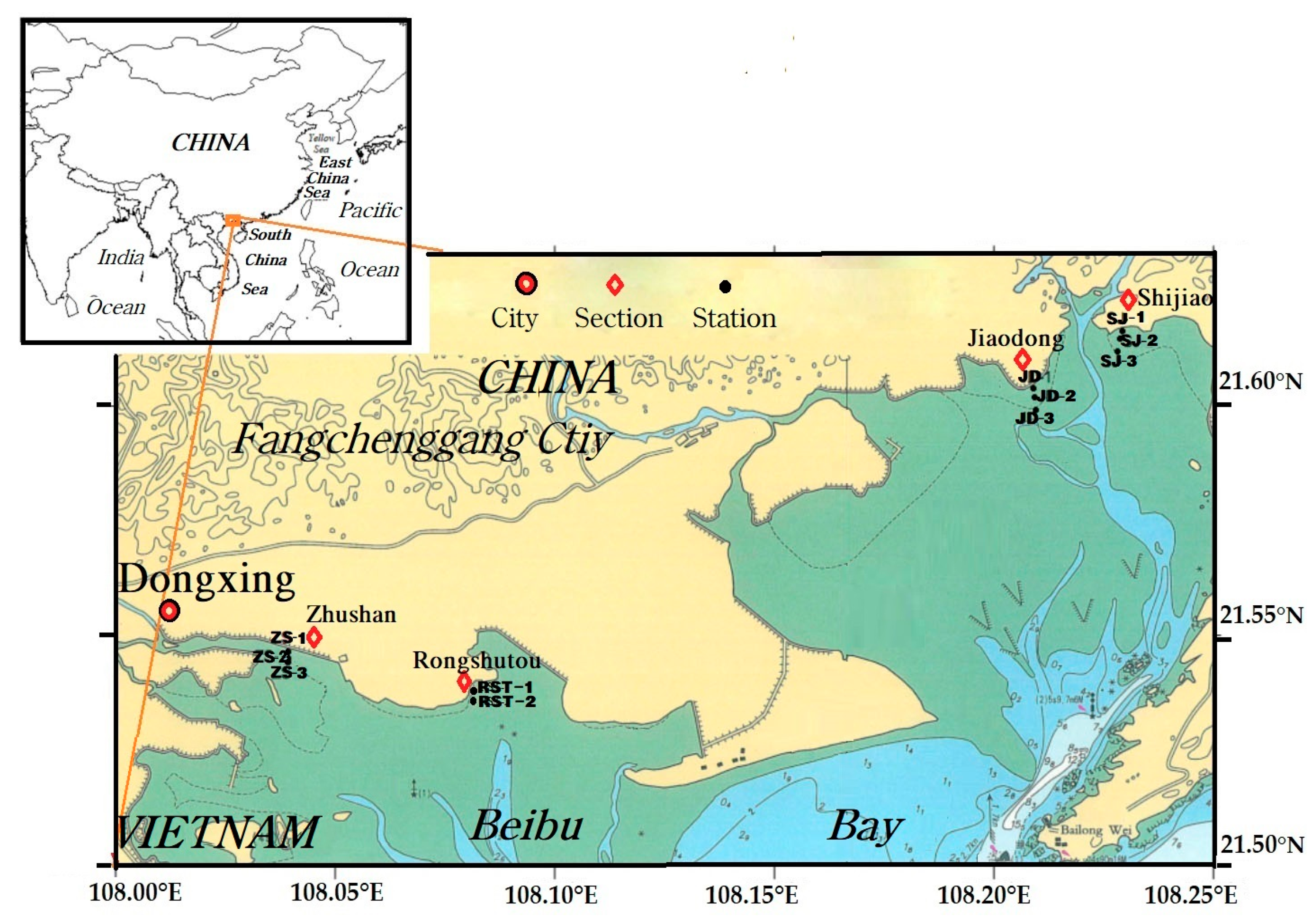
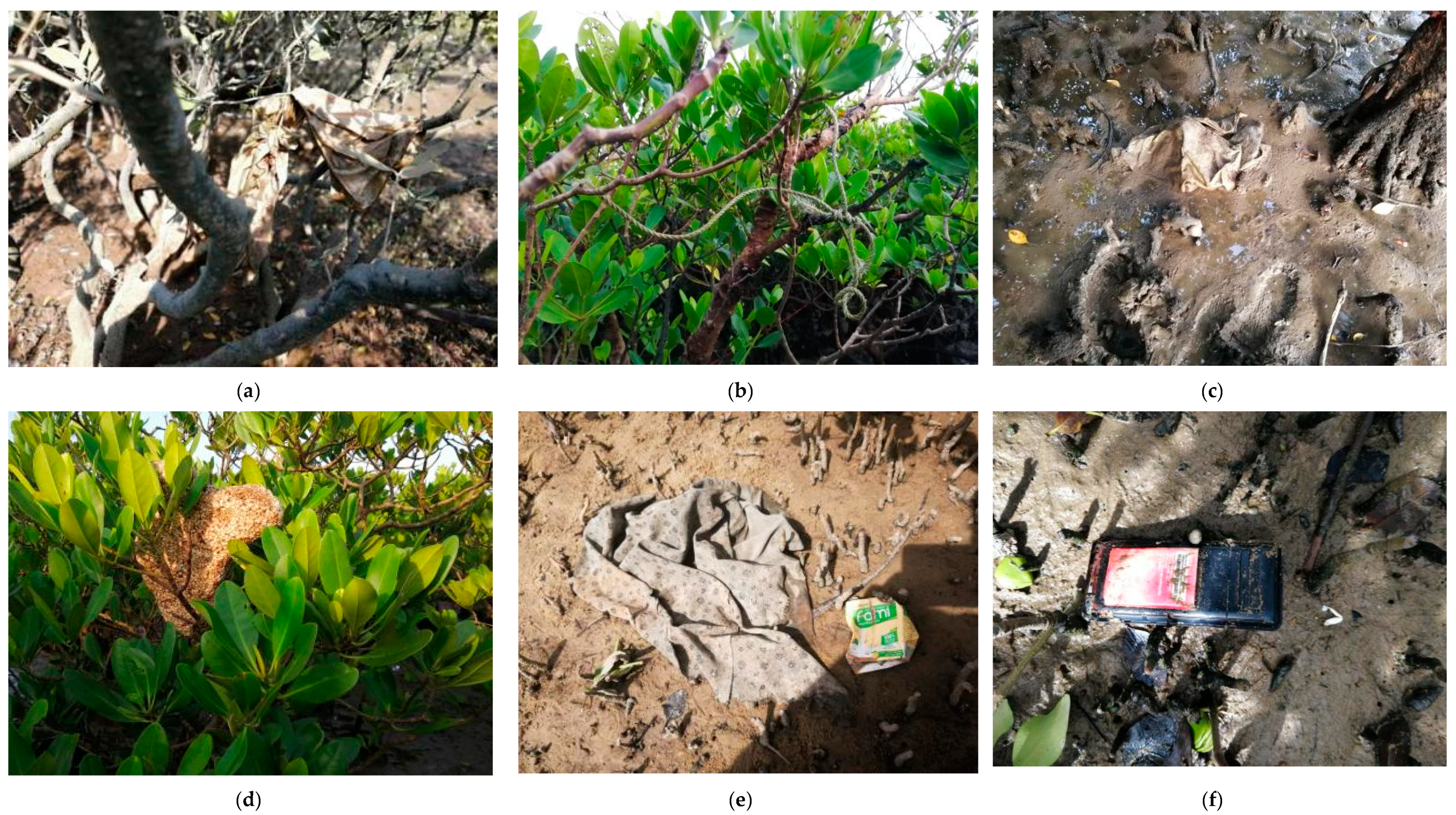
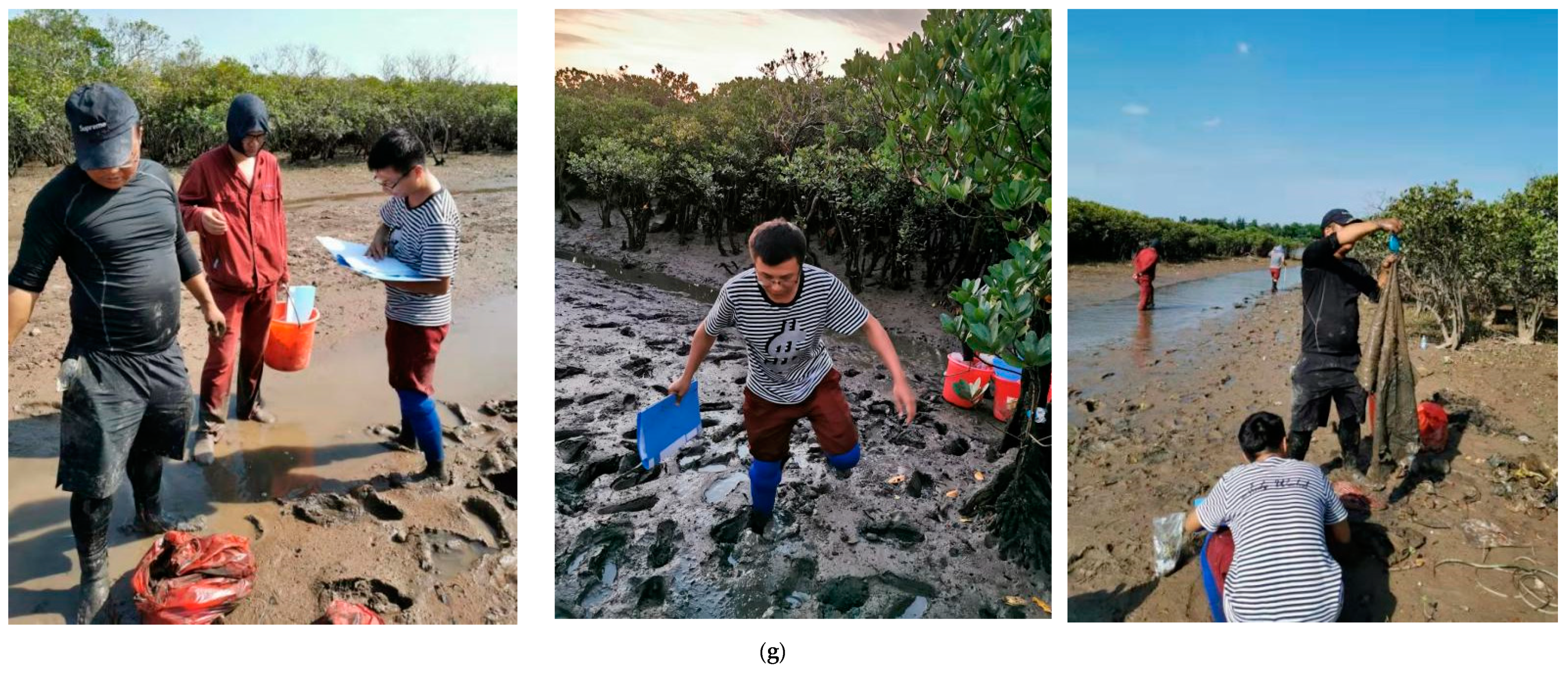
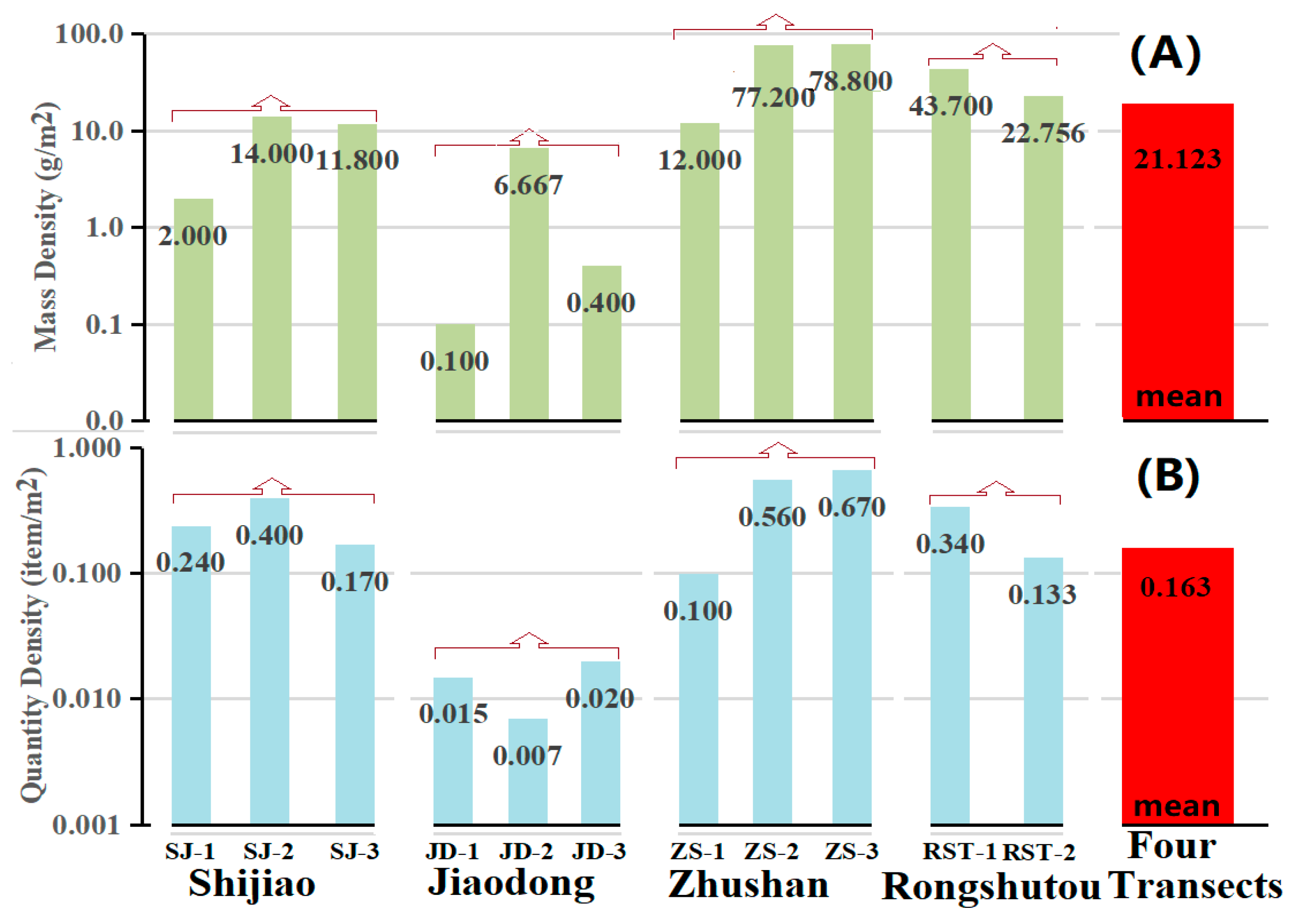
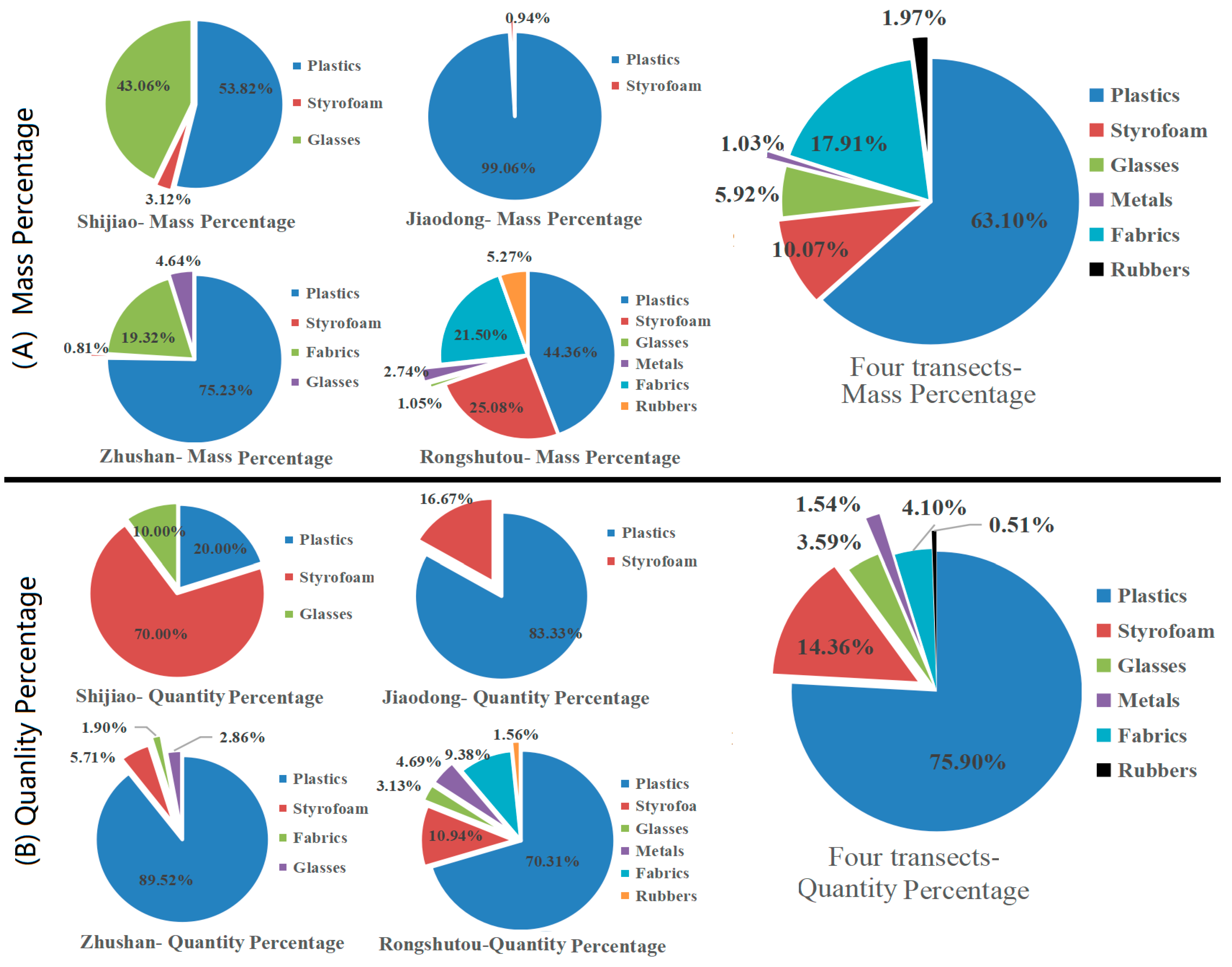
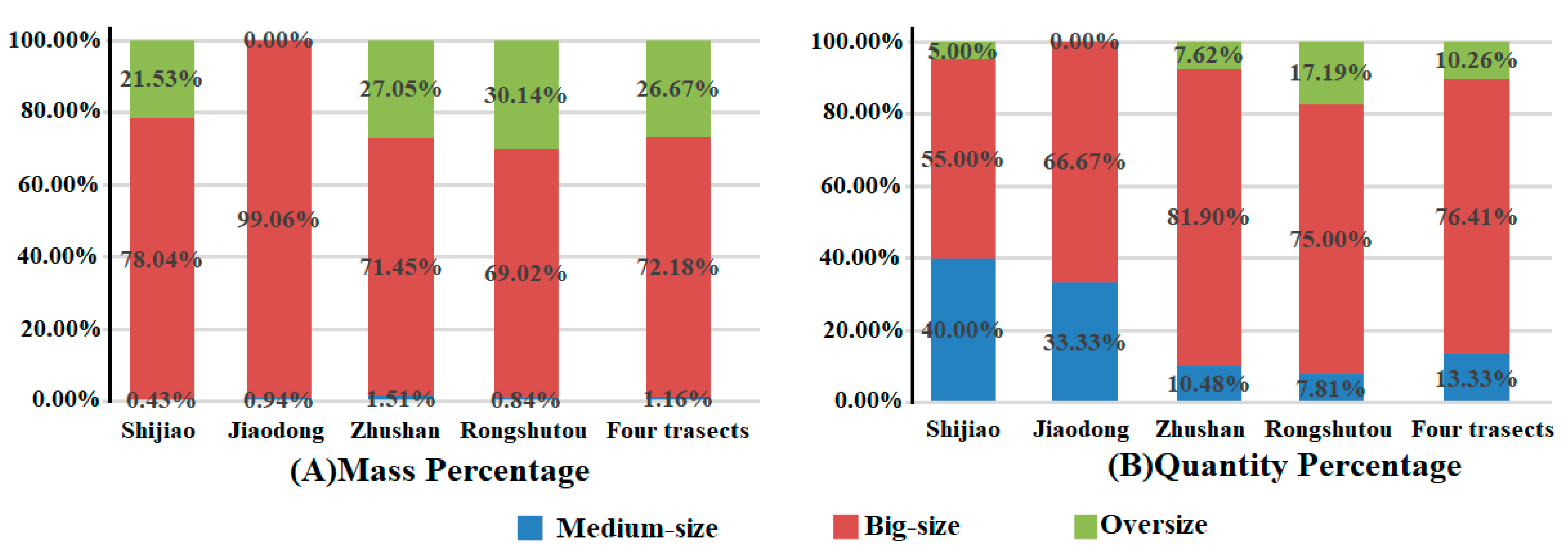
| Classification | Specific Examples | |
|---|---|---|
| Materials/ Composition (plastics, Styrofoam, wood, paper, metal, rubber, fabric/fiber, glass, other material) * | Plastics | Bags, bottles, cigarette filters, lighters, buckets, lid, spoons, knives and forks, straws, hats, diapers, syringes, fishing lines, nets, floats, safety helmets, feeding bottles, ropes, toys, rings, old plastic boat, etc.; |
| Styrofoam | Buoys, cups, foam boxes, fast food boxes (plates), etc.; | |
| Glasses | Bottles, fluorescent tubes, bulbs, glass fragments, etc.; | |
| Metals | metal barrels, beverage cans, metal plates, metal fragments, iron wires, etc.; | |
| Rubbers | balloons, rubber gloves, tires, condoms, etc.; | |
| Fabrics | Clothes, rags and textile materials, etc.; | |
| Wood products # | Furniture, crates, chopsticks, wooden cases, old wooden boat, etc.; | |
| Papers $ | Paper bags, cardboards, cups, newspapers, etc.; | |
| Others | Other artificial articles and unrecognizable materials | |
| Size | Small-size (<2.5 cm), Medium-size (≥2.5 cm and ≤10 cm), Large-size (>10 cm and ≤1 m) or Oversize (>1 m) debris | |
| Sources | Sea sources | coastal/recreational activity, navigation/fishing activity, medical or sanitary activity and other disposal source (e.g., wood, ceramics, plastic pieces, glass slices) |
| Land sources | ||
| Transect | Date | Station | Area (m2) | Debris | Station of Rising and Falling Tide | |
|---|---|---|---|---|---|---|
| Shijiao | 28 August 2019 | SJ-1 | 108.2282° E, 21.6169° N | 5 × 5 | Foam particles | High-tide station |
| SJ-2 | 108.2284° E, 21.6152° N | 10 × 5 | Beer bottle, plastic woven bag | Medium-tide station | ||
| SJ-3 | 108.2283° E, 21.6142° N | 10 × 10 | Beer bottle, broken buoy, plastic reticule, mineral water bottle, foam particles | Low-tide station | ||
| Jiaodong | 28 August 2019 | JD-1 | 108.2042° E, 21.6028° N | 15 × 10 | Foam, plastic cup | High-tide station |
| JD-2 | 108.2053° E, 21.6016° N | 15 × 10 | Plastic woven bag | Medium-tide station | ||
| JD-3 | 108.2053° E, 21.6000° N | 10 × 10 | Plastic bag, rope | Low-tide station | ||
| Zhushan | 29 August 2019 | ZS-1 | 108.0399° E, 21.5469° N | 10 × 10 | Small/big plastic bag | High-tide station |
| ZS-2 | 108.0396° E, 21.5469° N | 10 × 5 | Plastic packing bag, woven bag, big plastic bag, mineral water bottle, plastic disposal cup, foam | Medium-tide station | ||
| ZS-3 | 108.0382° E, 21.5468° N | 10 × 10 | Canvas, pants, beer bottle, woven bag, small/big plastic bag, plastic bag, fruits packing net, plastic cup/drink bottle/food box, foam fast food box, packing rope, pipe | Low-tide station | ||
| Rongshu tou | 30 August 2019 | RST-1 | 108.0806° E, 21.5388° N | 10 × 10 | Foam, small plastic bag, glass bottle, ring-pull can, motorbike pedal (metal), plastic drug board, used clothes, shoes, rubber tyre, rope, cellphone | High-medium-tide station |
| RST-2 | 108.0878° E, 21.5375° N | 15 × 15 | fishing nets, plastic film, foam, metal food bottle, woven bag, used clothes, cotton gloves | Low-tide station | ||
| Types | D-Mass (g/m2) | Ms-p.c. (%) | D-Qt (item/m2) | Qt-p.c. (%) | Stations | Types | Area (m2) | Weights (g) | D-Ms (g/m2) | Ms-p.c. (%) | Item | D-Qt (item/m2) | Qt-p.c. (%) |
|---|---|---|---|---|---|---|---|---|---|---|---|---|---|
| Shijiao transect (Station of SJ-1, SJ-2, and SJ-3 )Area = 175 m2 | SJ-1 | Styrofoam | 25 | 50 | 2.000 | 100 | 6 | 0.240 | 100 | ||||
| SJ-2 | Plastics | 50 | 300 | 8.000 | 57.14 | 1 | 0.020 | 50.00 | |||||
| Styrofoam | 0.331 | 3.12 | 0.080 | 70.00 | Glasses | 400 | 6.000 | 42.86 | 1 | 0.020 | 50.00 | ||
| Plastics | 5.714 | 53.82 | 0.023 | 20.00 | D-Mean | - | 14.000 | - | - | 0.040 | - | ||
| Glasses | 4.571 | 43.06 | 0.011 | 10.00 | SJ-3 | Styrofoam | 100 | 8 | 0.080 | 0.72 | 8 | 0.080 | 66.67 |
| D-Mean | 10.617 | - | 0.024 | - | Plastics | 600 | 6.000 | 54.15 | 3 | 0.030 | 25.00 | ||
| Glasses | 500 | 5.000 | 45.13 | 1 | 0.010 | 8.33 | |||||||
| D-Mean | - | 11.800 | - | - | 0.120 | - | |||||||
| Jiaodong transect (Station JD-1, JD-2, and JD-3), Area = 450 m2 | JD-1 | Styrofoam | 200 | 10 | 0.050 | 50.00 | 1 | 0.005 | 33.33 | ||||
| Plastics | 10 | 0.050 | 50.00 | 2 | 0.010 | 66.67 | |||||||
| Styrofoam | 0.022 | 0.94 | 0.002 | 16.67 | D-Mean | - | 0.100 | - | - | 0.015 | - | ||
| Plastics | 2.333 | 99.06 | 0.011 | 83.33 | JD-2 | Plastics | 150 | 1000 | 6.667 | 100.00 | 1 | 0.007 | 100.00 |
| D-Mean | 2.355 | - | 0.013 | - | JD-3 | Plastics | 100 | 40 | 0.400 | 100.00 | 2 | 0.020 | 100.00 |
| Zhushan transect (Station ZS-1, ZS-2, and ZS-3), Area = 250 m2 | ZS-1 | Plastics | 100 | 1200 | 12.000 | 100.00 | 10 | 0.100 | 100.00 | ||||
| ZS-2 | Styrofoam | 50 | 80 | 1.600 | 50.00 | 4 | 0.080 | 50.00 | |||||
| Styrofoam | 0.420 | 0.81 | 0.024 | 5.71 | Plastics | 3780 | 75.600 | 50.00 | 24 | 0.480 | 50.00 | ||
| Plastics | 38.940 | 75.23 | 0.376 | 89.52 | D-Mean | - | 77.200 | - | - | 0.560 | - | ||
| Fabrics | 10.000 | 19.32 | 0.008 | 1.90 | ZS-3 | Styrofoam | 100 | 25 | 0.250 | 0.32 | 2 | 0.020 | 2.99 |
| Glasses | 2.400 | 4.64 | 0.012 | 2.86 | Plastics | 4755 | 47.550 | 60.34 | 60 | 0.600 | 89.55 | ||
| D-Mean | 51.760 | - | 0.420 | - | Fabrics | 2500 | 25.000 | 31.73 | 2 | 0.020 | 2.99 | ||
| Glasses | 600 | 6.000 | 7.61 | 3 | 0.030 | 4.48 | |||||||
| D-Mean | - | 78.800 | - | - | 0.670 | - | |||||||
| Rongshutou transect (Station RST-1 and RST-2), Area = 425 m2 | RST-1 | Styrofoam | 100 | 2300 | 23.000 | 52.63 | 2 | 0.020 | 5.88 | ||||
| Plastics | 1010 | 10.100 | 23.11 | 24 | 0.240 | 70.59 | |||||||
| Styrofoam | 7.323 | 25.08 | 0.022 | 10.94 | Glasses | 100 | 1.000 | 2.29 | 2 | 0.020 | 5.88 | ||
| Plastics | 12.954 | 44.36 | 0.138 | 70.31 | Metals | 160 | 1.600 | 3.66 | 2 | 0.020 | 5.88 | ||
| Glasses | 0.308 | 1.05 | 0.006 | 3.13 | Fabrics | 300 | 3.000 | 6.86 | 3 | 0.030 | 8.82 | ||
| Metals | 0.800 | 2.74 | 0.009 | 4.69 | Rubbers | 500 | 5.000 | 11.44 | 1 | 0.010 | 2.94 | ||
| Fabrics | 6.277 | 21.50 | 0.018 | 9.38 | D-Mean | - | 43.700 | - | - | 0.340 | - | ||
| Rubbers | 1.538 | 5.27 | 0.003 | 1.56 | RST-2 | Plastics | 225 | 3200 | 14.222 | 62.50 | 21 | 0.093 | 70.00 |
| D-Mean | 29.200 | - | 0.197 | - | Styrofoam | 80 | 0.356 | 1.56 | 5 | 0.022 | 16.67 | ||
| Metals | 100 | 0.444 | 1.95 | 1 | 0.004 | 3.33 | |||||||
| Fabrics | 1740 | 7.733 | 33.98 | 3 | 0.013 | 10.00 | |||||||
| D-Mean | - | 22.756 | - | - | 0.133 | - | |||||||
| Four transects (Shijiao, Jiaodong, Zhushan, and Rongshutou), Area = 1200 m2 | Total | Styrofoam | 1200 | 2553 | 2.128 | 10.07 | 28 | 0.123 | 14.36 | ||||
| Plastics | 15,995 | 13.329 | 63.10 | 148 | 0.023 | 75.90 | |||||||
| Glasses | 1500 | 1.250 | 5.92 | 7 | 0.006 | 3.59 | |||||||
| Metals | 260 | 0.217 | 1.03 | 3 | 0.003 | 1.54 | |||||||
| Fabrics | 4540 | 3.783 | 17.91 | 8 | 0.007 | 4.10 | |||||||
| Rubbers | 500 | 0.417 | 1.97 | 1 | 0.001 | 0.51 | |||||||
| D-Mean | 25,348 | 21.123 | - | 195 | 0.163 | - | |||||||
| Sources | Types | Ms-p.c. (%) | Qt-p.c. (%) | Debris Items | |
|---|---|---|---|---|---|
| Land-based | Coastal/Recreationalactivity | Styrofoam | 10.07% | 14.36% | Particles, foam fast food box, etc. |
| Plastics | 53.79% | 68.72% | Plastic film, plastic bag (woven bag, plastic reticule, packing bag), plastic bottle/box/cup (mineral water bottle, drink bottle/food box, disposal cup), fruits packing net, packing rope, pipe, cellphone, etc. | ||
| Glasses | 5.92% | 3.59% | Beer bottle, glass bottle/cup | ||
| Metals | 1.03% | 1.54% | ring-pull can, metal food bottle, motorbike pedal | ||
| Rubbers | 17.91% | 4.10% | Rubber tire | ||
| Fabrics | 1.97% | 0.51% | Used clothes, shoes, pants, cotton gloves | ||
| Total | 90.69% | 92.82% | - | ||
| Land-based | Medical or sanitary activity | Plastics | 0.12% | 1.54% | Plastic drug board |
| Sea-based | Navigation/fishing activity | Plastics | 9.19% | 5.64% | Fishing nets, broken buoy, rope |
| Area | 1200 m2 of Survey Area | ~1.3 × 107 m2 of Mangrove Area | ||
|---|---|---|---|---|
| Classification | D-Ms (g/m2) | Debris Weights (ton) | ||
| Mean | Range | Mean | Range | |
| Plastics | 13.329 | 2.333~38.940 | 173.3 | 30.3~506.2 |
| Styrofoam | 2.128 | 0.022~7.323 | 27.7 | 0.3~95.2 |
| Fabrics | 3.783 | 0~10.00 | 49.2 | 0~130.0 |
| Rubbers | 0.417 | 0~1.538 | 5.4 | 0~20.0 |
| Metals | 0.217 | 0~0.800 | 2.8 | 0~10.4 |
| Glasses | 1.250 | 0~2.400 | 16.2 | 0~31.2 |
| All debrs | 21.123 | 2.355~51.760 | 274.6 | 30.65~672.9 |
| Transect | Mass Weights (g) | Quantity (Item) | |||||
|---|---|---|---|---|---|---|---|
| Medium-Size | Big-Size | Oversize | Medium-Size | Big-Size | Oversize | ||
| Shijiao | Weight/Quantity | 8 | 1450 | 400 | 8 | 11 | 1 |
| p.c (%) | 0.43 | 78.04 | 21.53 | 40.00 | 55.00 | 5.00 | |
| Jiaodong | Weight/Quantity | 10 | 1050 | 0 | 2 | 4 | 0 |
| p.c (%) | 0.94 | 99.06 | 0.00 | 33.33 | 66.67 | 0.00 | |
| Zhushan | Weight/Quantity | 195 | 9245 | 3500 | 11 | 86 | 8 |
| p.c (%) | 1.51 | 71.45 | 27.05 | 10.48 | 81.90 | 7.62 | |
| Rongshutou | Weight/Quantity | 80 | 6550 | 2860 | 5 | 48 | 11 |
| p.c (%) | 0.84 | 69.02 | 30.14 | 7.81 | 75.00 | 17.19 | |
| Four transects | Weight/Quantity | 293 | 18,295 | 6760 | 26 | 149 | 20 |
| p.c (%) | 1.16 | 72.18 | 26.67 | 13.33 | 76.41 | 10.26 | |
Publisher’s Note: MDPI stays neutral with regard to jurisdictional claims in published maps and institutional affiliations. |
© 2021 by the authors. Licensee MDPI, Basel, Switzerland. This article is an open access article distributed under the terms and conditions of the Creative Commons Attribution (CC BY) license (https://creativecommons.org/licenses/by/4.0/).
Share and Cite
Li, D.; Zhao, L.; Guo, Z.; Yang, X.; Deng, W.; Zhong, H.; Zhou, P. Marine Debris in the Beilun Estuary Mangrove Forest: Monitoring, Assessment and Implications. Int. J. Environ. Res. Public Health 2021, 18, 10826. https://doi.org/10.3390/ijerph182010826
Li D, Zhao L, Guo Z, Yang X, Deng W, Zhong H, Zhou P. Marine Debris in the Beilun Estuary Mangrove Forest: Monitoring, Assessment and Implications. International Journal of Environmental Research and Public Health. 2021; 18(20):10826. https://doi.org/10.3390/ijerph182010826
Chicago/Turabian StyleLi, Dongmei, Li Zhao, Zhiming Guo, Xi Yang, Wei Deng, Haoxiang Zhong, and Peng Zhou. 2021. "Marine Debris in the Beilun Estuary Mangrove Forest: Monitoring, Assessment and Implications" International Journal of Environmental Research and Public Health 18, no. 20: 10826. https://doi.org/10.3390/ijerph182010826
APA StyleLi, D., Zhao, L., Guo, Z., Yang, X., Deng, W., Zhong, H., & Zhou, P. (2021). Marine Debris in the Beilun Estuary Mangrove Forest: Monitoring, Assessment and Implications. International Journal of Environmental Research and Public Health, 18(20), 10826. https://doi.org/10.3390/ijerph182010826







